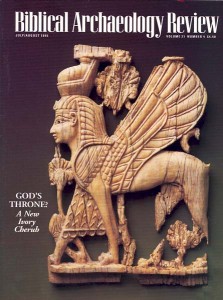An Iconographic History: Symbols of Royalty and Divinity
Sidebar to: Cherubim: God’s Throne?
The openwork ivory plaque in the Bible Lands Museum is a masterpiece of ivory carving. The stylistic features are typically Phoenician of the ninth century B.C.E.: elongated slender figures; symmetrical composition; and clear Egyptian elements.
As in Egyptian paintings, the face is depicted in profile. This is typical of Phoenician ivories, whereas faces in contemporaneous Syrian ivories are shown frontally.
The Egyptian elements include the double crown of Upper and Lower Egypt, the Egyptian wig, the Uraeus, or snake, on the wig over the forehead (seen in profile), the rounded shoulder depicting the Egyptian pectoral in profile, and the lotus thicket that provides the setting.
Judging from other examples, we can assume that the figure was matched by a second one, with the two figures facing one another. Between these two figures rested a schematized palm tree symbolizing abundance.
This plaque was originally part of a larger construction made of two or more plaques of this size probably inlaid into pieces of elegant furniture as part of a larger scene. The plaque was cut vertically from the central section of an elephant’s tusk.
Composite creatures similar to this one have been found in almost all first-millennium ivory collections—in Arslan Tash, Nimrud, Khorsabad, Samaria and Salamis. The Egyptian elements reflect the cultural connections between Egypt and these areas on the Mediterranean coast, as well as inland. Egyptian influence can be perceived as early as the third millennium B.C.E.
Already a library member? Log in here.
Institution user? Log in with your IP address.

